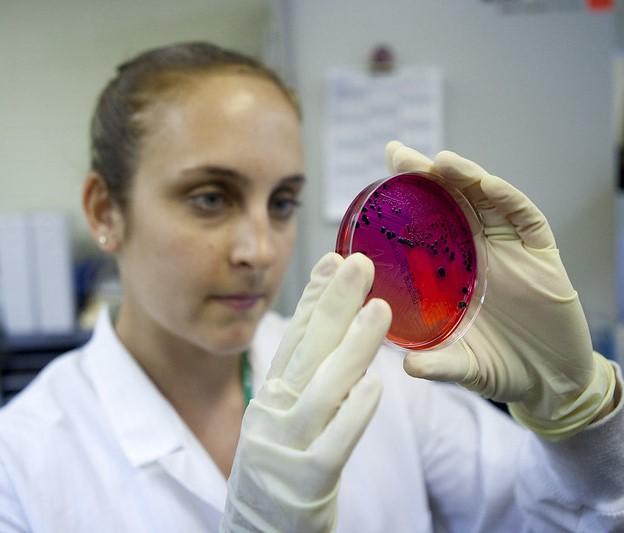Antibiotic-resistant Salmonella infections are on the rise, according to new research by scientists with the Centers for Disease Control and Prevention (CDC).
In a study published today in Emerging Infectious Diseases, the researchers estimated a 40% increase in the annual incidence of nontyphoidal Salmonella infections with clinically important resistance in 2015-2016 compared with 2004-2008. When extrapolated to the entire US population, that amounts to roughly 63,000 more infections a year caused by antibiotic-resistant Salmonella.
While changes in the incidence of resistance varied by region and serotype, two serotypes—I 4,[5],12:i:- and Enteritidis—accounted for two thirds of the increase in resistant infections. Ciprofloxacin-nonsusceptible infections accounted for more than half.
Salmonella is one of the leading causes of foodborne infections in the United States. Although most Salmonella infections are self-limiting and don't require antibiotic treatment, some infections are more severe. The CDC estimates nontyphoidal Salmonella causes an estimated 1.35 million infections, 26,500 hospitalizations, and 420 deaths per year. Resistant infections can cause more severe illness, and treatment failure has been reported for infections with reduced susceptibility to ciprofloxacin.
40% increase in annual incidence
To estimate the national changes of resistant Salmonella infections, the CDC researchers looked at human Salmonella infections reported to public health laboratories and local health departments through the Laboratory-Based Enteric Disease Surveillance (LEDS) from 2004 to 2016.
They also tested Salmonella isolates collected through the National Antimicrobial Resistance Monitoring System (NARMS). While the researchers assessed isolate susceptibility to agents representing 8 to 9 antibiotic classes, they focused on identifying resistance to ceftriaxone and ampicillin and nonsusceptibility to ciprofloxacin. These are the three agents primarily used to treat severe Salmonella infections.
The researchers used Bayesian models to generate estimates for Salmonella infection incidence rates, resistance proportions, and resistant infection incidence rates for six serotype categories, then compared the mean resistance incidence from 2015-2016 with two 5-year reference periods—2004 through 2008, and 2010 through 2014.
Over the entire study period, states reported 539,862 culture-confirmed Salmonella infections to LEDS and submitted 28,265 Salmonella isolates to NARMS. The most common serotypes were Enteritidis, Typhimuirum, Newport, I 4,[5],12:i:-, and Heidelberg.
Clinically important resistance was detected in 3,456 (12.5%) of the 28,265 isolates, with ampicillin-only resistance detected in 6.6%, ciprofloxacin nonsusceptibility in 3%, and ceftriaxone/ampicillin resistance in 3%. Multidrug resistance was detected in 10.3% of isolates. The five major serotypes accounted for 69% of infections with clinically important resistance and 66% with multidrug resistance.
During 2015-2016, the mean annual incidence of infections with any clinically important resistance was 2.38 per 100,000 persons, increasing by 0.68 per 100,000 persons compared with 2004-2008 (there was no significant change compared with 2010-2014). Serotype I 4,[5],12:i:- and Enteritidis accounted for 37% and 26% of the increase in clinically important resistant infections, respectively. The mean annual incidence of ciprofloxacin-nonsusceptible infections increased by 0.41 per 100,000 persons compared with 2004-2008, and by 0.29 per 100,000 persons compared with 2010-2014.
"The increased incidence of ciprofloxacin-nonsusceptible Salmonella infections during 2015-2016 compared with both 2004-2008 and 2010-2014 is a concerning trend," the study authors wrote.
Resistant infections caused by other, less common Salmonella serotypes that have emerged in recent years, including Dublin, Infantis, and Kentucky, also rose compared with 2004-2008, and accounted for 37% of the increase in resistant infections.
When they extrapolated the incidence estimates to the entire US population, the researchers estimated that resistant Salmonella infections rose from an average of 159,000 per year in 2004-2008 to 222,000 in 2015-2016.
Links to animal antibiotic use, international travel
Although the study did not examine the causes of increasing resistance in Salmonella, the authors hint at a few possible sources. For example, they note that the increase in ampicillin-only and multidrug-resistant Salmonella I 4,[5],12:i:- infections was highest in the West and Midwest regions, two areas of the country where pork production and consumption is high.
The use of medically important antibiotics in US pork production is widespread. A 2019 report from the US Department of Agriculture showed that just over 90% of swine operations gave pigs medically important antibiotics. The CDC researchers note that pork products have been linked to resistant I 4,[5],12:i:- infections in the West. They also cite a study that identified multidrug-resistant I 4,[5],12:i:- strains in swine in the Midwest, some of which carried plasmid-mediated resistance genes.
"This trend could partly explain the widespread increase in the incidence of MDR I 4,[5],12:i:- infections," they wrote.
International travel is another potential source.
"International travel could have contributed to an increase in the incidence of ciprofloxacin-nonsusceptible Enteritidis infections, which increased in 3 regions and was highest in the Northeast," the authors wrote. "International travel has increased since 2014, and residents of northeastern states accounted for more than one third of US travelers during 2015–2016."
They suggest further analysis of changes in resistance incidence could help identify targeted prevention strategies.

























